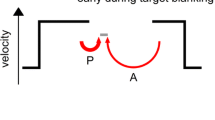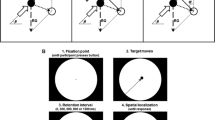Abstract
Although the occurrence of visual processing and eye-movement disorders in schizophrenia have been widely recognized, their relationship with the symptoms of schizophrenia is less well understood. In two experiments the relationship between directional-motion processing and smooth-pursuit eye movement was investigated in normal observers and in groups with positive and negative symptoms in schizophrenia. The first experiment measured linear smooth-pursuit eye movement at six target velocities from 5.0 to 30.0° s−1 and the second experiment measured directional motion-contrast sensitivity at three spatial (1.0, 4.0 and 8.0 c/deg) and five temporal (0.75, 3.0, 6.0, 12.0 and 18.0 Hz) frequencies in the same groups of observers. No significant differences were found between the control and positive-symptom group in directional motion-contrast sensitivity and smooth-pursuit eye movements. In comparison, a relationship was found between a significant reduction in directional motion-contrast sensitivity and significantly reduced smooth-pursuit eye movement in the negative-symptom group and serves to further cleave the distinction between positive and negative symptoms in schizophrenia. The relationship between visual motion processing and pursuit eye movement in the negative-symptom group was explained by a disorder in directional motion processing that fails to fully engage the pursuit eye movement system and reduces smooth pursuit eye-velocity gain.



Similar content being viewed by others
References
American Psychiatric Association 4th edn (1992) Diagnostic and statistical manual of mental disorders. American Psychiatric Association, Washington, DC
Andreasen NC (1981) Scale for the assessment of negative symptoms (SANS). University of Iowa, Iowa City, IA
Andreasen NC (1983) Scale for the assessment of positive symptoms (SANS). University of Iowa, Iowa City, IA
Andreasen NC, Olsen SA (1982) Negative, positive schizophrenia: definition and validation. Arch Gen Psychiatry 39:789–795
Andreasen NC, Flaum M, Arndt S, Alliger R., Swayze VW (1991) Positive and negative symptoms: assessment and validity. In: Marneros A, Andreassen NC, Tsuang MT (eds) Negative versus positive schizophrenia. Springer, Berlin Heidelberg New York, pp 28–51
Benitez JT (1970) Eye-tracking and optokinetic tests: diagnostic significance in peripheral and central vestibular disorders. Laryngoscope 80:834–848
Bonnet C (1982) Thresholds of motion perception. In: Wertheim AH, Wagenaar WH, Leibowitz HW (eds) Tutorials in motion perception. Plenum Press, New York, pp 1–79
Borst A, Engelhaaf M (1989) Principles of visual motion detection. Trends Neurosci 6:177–179
Burr DC, Ross J (1982) Contrast sensitivity at high velocities. Vision Res 22:479–484
Carpenter WT, Heinrichs DW, Wagman AM (1988) Deficit and nondeficit forms in schizophrenia, the concept. Am J Psychiatry 145:578–583
Chen Y, Levy DL, Nakayama K, Matthysse S, Palafox G, Holzman PS (1999a) Dependence of impaired eye tracking on deficient velocity discrimination in schizophrenia. Arch Gen Psychiatry 56:155–161
Chen Y, Palafox GP, Nakayama K, Levy DC, Matthysse S, Holzman PS (1999b) Motion perception in schizophrenia. Arch Gen Psychiatry 56:149–154
Churchland MM, Lisberger SG (2000) Apparent motion produces multiple deficits in visually guided smooth-pursuit eye movements in monkeys. J Neurophys 84:216–235
Crow TJ (1985) The two-syndrome concept: origins and current status. Schizophr Bull 11:471–486
Crow TJ (1995) Brain changes in negative symptoms in schizophrenia. Psychopathology 28:18–21
Diefendorf AR, Dodge R (1908) An experimental study of the ocular reactions of the insane from photographic records. Brain 31:451–489
Enroth-Cugell CA, Robson JG (1966) The contrast sensitivity of retinal ganglion cells of the cat. J Physiol 187:517–552
Groh JM, Born RT, Newsome WT (1997) How is a sensory map readout? Effects of microstimulation in visual area MT on saccades and smooth-pursuit eye movements. J Neurosci 17:4312–4330
Hain TC (1995) Real time experimentation (REX)/mark program documentation. Northwestern University, 645 N. Michigan, Suite 1085; Chicago, IL
Holtzman PS, Proctor LR, Hughes DW (1973) Eye tracking pattern in schizophrenia. Science 81:179–181
Hubel DH, Wiesel TN (1962) Receptive fields, binocular interaction, and functional architecture of the cat’s visual cortex. J Physiol 160:106–154
Hutton S, Kennard C (1998) Oculomotor abnormalities in schizophrenia. Neurol 50:604–609
Iacono WG (1988) Eye movement abnormalities in schizophrenic and affective disorders. In: Johnston CW, Pirozollo FJ (eds) Neuropsychology of eye-movements. Lawrence Erlbaum, New York
Kaplan E, Lee BB, Shapley RM (1990) New views of primate retinal function. In: Osborne NN, Chader GJ (eds) Progress in retinal research, vol 9. Pergamon Press, Oxford
Katcher BS, Young LY, Koda-Kimble MA (1988) Applied therapeutics: the clinical use of drugs, 4th edn. Applied therapeutics Inc.,Vancouver, Canada
Katsanis J, Iacono W (1991) Clinical, neuropsychological, and brain structure correlates of smooth-pursuit eye movement performance in chronic schizophrenics. J Abnorm Psychol 100:526–534
Kay SR, Opler LA, Fiszbein A (1986) Positive and negative symptom scale manual. Multi-health systems Inc., North Tonawanda, NY, USA
Keefe R, Siever L, Mohs R, Peterson AE, Mahon TR, Berman RL, Davis KL (1989) Eye tracking, schizophrenic symptoms, and schizotypal personality disorder. Eur Arch Psychiatr Neurol Sci 239:39–42
Kelly DH (1977) Visual contrast sensitivity. Opt Acta 24:107–129
Kelly P, Rennie C, Gordon E, Anderson J, Howson A, Meares R (1990) Smooth pursuit eye tracking dysfunction and negative symptoms in schizophrenia. Psychiatr Res 34:89–97
Leigh RJ, Zee DS (1999) The neurology of eye movements, 3rd edn. Oxford University Press, Oxford
Levy DL, Holzman PS, Matthysse S, Mendell NR (1993) Eye tracking dysfunction in schizophrenia: a critical perspective. Schizophr Bull 19:461–536
Lieberman J, Jody D, Alvir J, Ashtari M, Levy DL, Bogertz B, Degreef G, Mayerhoff DI, Cooper T (1993) Brain morphology, dopamine and eye tracking in first episode schizophrenia. Prevalence and clinical correlates. Arch Gen Psychiatry 50:357–368
Lisberger SG, Morris EJ, Tychsen L (1987) Visual motion processing and sensory motor integration for smooth-pursuit eye movements. Ann Rev Neurosci 10:97–129
Macavoy MG, Bruce CJ (1995) Comparison of the smooth eye movement tracking disorder of schizophrenics with that of nonhuman primates with specific brain lesions. Int J Neurosci 80:117–151
Maunsell JHR, Newsome WT (1987) Visual processing in monkey extrastriate cortex. Ann Rev Neurosci 10:363–401
Morgan MJ, Turnbull DF (1978) Smooth eye tracking and the perception of motion in the absence of real movement. Vision Res 18:1050–1059
Morris EJ, Lisberger SG (1987) Different responses to small visual errors during initiation and maintenance of smooth-pursuit eye movements in monkeys. J Neurophys 58:1351–1369
Nelson HE (1983) National adult reading test (NART). Nfer-Nelson Publishing Co., Windsor
Newsome WT, Pare EA (1988) Selective impairment of motion perception following lesions of middle temporal visual area (MT). J Neurosci 8:2201–2211
Newsome WT, Wurtz RH, Dursteler MR, Mikami A (1985) Deficits in visual motion processing following ibotenic lesions of the middle temporal visual area of the macaque monkey. J Neurosci 5:825–840
Newsome WT, Wurtz RH, Mikami A (1988) Relation of cortical areas MT and MST to pursuit eye movements. II. Differentiation of retinal from extraretinal inputs. J Neurophys 60:594–620
Nkam I, Thibaut F, Denise P, Van Der Elst A, Segard L, Brazo P, Menard JF, Thery S, Halbeck I, Delamilleure P, Vasse T, Etard O, Dollfus S, Champion D, Levillian D, Petit M (2001) Saccadic and smooth-pursuit eye movements in deficit and non-deficit schizophrenia. Schizophr Res 48:145–153
Page WK, King WM, Merigan W, Maunsell J (1994) Magnocellular or parvocellular lesions in the lateral geniculate nucleus of monkeys cause minor deficits of smooth-pursuit eye movements. Vision Res 34:223–239
Reichardt W (1961) Autocorrelation, a principle for the evaluation of sensory information by the central nervous system. MIT Press, Cambridge, MA
Reulen JPH, Marcus JT, Koops D, De Vries FR, Tiesinga G, Boshuizen K, Bos JE (1988) The precise recording of eye movement, the IRIS technique. Part 1. Med Biol Eng Comp 26:20–26
Roitman SEL, Keefe RSE, Harvey PD, Siever LJ, Mohs RC (1997) Attentional and eye tracking deficits correlate with negative symptoms in schizophrenia. Schizophr Res 26:139–146
Ross DE, Thaker GK, Buchanan RW, Lahti AC, Medoff D, Bartko JJ, Moran M, Hartley J (1996) Association of abnormal smooth-pursuit eye movements with the deficit syndrome in schizophrenic patients. Am J Psychiatry 153:1158–1165
Ross DE, Thaker GK, Buchanan RW, Kirkpatrick B, Lahti AC, Medoff D, Bartko JJ, Goodman J, Tien A (1997) Eye tracking disorder in schizophrenia is characterised by specific oculomotor defects and is associated with the deficit syndrome. Biol Psychiatry 42:781–796
Shapley RM, Lennie P (1985) Spatial frequency analysis in the visual system. Ann Rev Neurosci 8:547–583
Slaghuis WL (1998) Contrast sensitivity for stationary and drifting spatial frequency gratings in positive and negative symptom schizophrenia. J Abnorm Psychol 107:49–62
Slaghuis WL, Bakker VJ (1995) Forward and backward masking of contour by light in positive- and negative symptom schizophrenia. J Abnorm Psychol 104:41–54
Slaghuis WL, Bishop AM (2001) Luminance flicker sensitivity in positive- and negative- symptom schizophrenia. Exp Brain Res 138:88–99
Slaghuis WL, Curran C (1999) Spatial frequency masking in positive and negative symptom schizophrenia. J Abnorm Psychol 10842–50
Smith AT (1991) Limits of velocity perception. In: Kulikowski JJ, Walsh V, Murray IJ (eds) Vision and visual dysfunction, vol 5, Limits of vision. Macmillan, London (In USA by CRC Press, Boca Raton, FL)
Smith AT, Edgar GK (1994) Antagonistic comparison of temporal frequency filter outputs as a basis for speed perception. Vision Res 34:253–266
Stuve TA, Friedman L, Jesberger JA, Gilmore GC, Straus ME, Meltzer HY (1997) The relationship between smooth pursuit performance, motion perception and sustained visual attention in patients with schizophrenia and normal controls. Psychol Med 27:143–152
Sweeney JA, Clementz BA, Haas GL, Escobar MD, Drake K, Francis AJ (1993) Mixture analysis of pursuit eye-tracking dysfunction in schizophrenia. Biol Psychiatry 34:331–340
Sweeney JA, Clementz BA, Haas GL, Escobar MD, Drake K, Francis AJ (1994) Eye tracking dysfunction in schizophrenia: characterisation of component eye movement abnormalities, diagnostic specificity and the role of attention. J Abnorm Psychol 103:222–230
Tolhurst DJ, Sharpe CR, Hart C (1973) The analysis of the drift rate of moving sinusoidal gratings. Vision Res 13:2545–2555
Tychsen L, Lisberger SG (1986) Visual motion processing for the initiation of smooth-pursuit eye movements in humans. J Neurophys 56:953–968
Watson AB, Robson JG (1981) Discrimination at threshold: labeled detectors in human vision. Vision Res 21:1115–1122
Wechsler D (1981) Wechsler adult intelligence scale–revised. The psychological corporation. Harcourt Brace Jovanovich, New York
Wertheim AH, Van Gelder P, Peselow LE, Cohen N (1985) High thresholds for movement perception in schizophrenia may indicate abnormal extraneous noise levels of central vestibular activity. Biol Psychiatry 20:1197–1210
Wetherill GB, Levitt H (1965) Sequential estimation of points on a psychometric function. Br J Math Stat Psychol 18:1–10
Acknowledgements
This research was funded by an Australian Research Council (ARC) Grant to the first author. The authors would like to express their gratitude to staff from the Tasmania Department of Health Division of Psychiatry, and all those who participated willingly and generously to this study, and Mrs Michelle Fahay who independently assessed the participants in this study.
Author information
Authors and Affiliations
Corresponding author
Rights and permissions
About this article
Cite this article
Slaghuis, W.L., Bowling, A.C. & French, R.V. Smooth-pursuit eye movement and directional motion-contrast sensitivity in schizophrenia . Exp Brain Res 166, 89–101 (2005). https://doi.org/10.1007/s00221-005-2347-1
Received:
Accepted:
Published:
Issue Date:
DOI: https://doi.org/10.1007/s00221-005-2347-1




